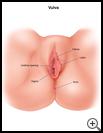
Episiotomy
What is an episiotomy?
An episiotomy is a 1- to 3-inch (2 to 4 cm) cut made in the tissue between the opening of the vagina and the rectum. It widens the opening of your vagina for childbirth. The cut can help avoid tearing into the vaginal wall and rectum during the delivery of your baby. It may also prevent injury to the baby if the baby's head is too large, the shoulders are too wide, or the baby is coming out feet or bottom first (a breech birth).
How is an episiotomy done?
Before the procedure:
- Your healthcare provider will ask you to sign a consent form for any necessary treatment during labor and delivery, including an episiotomy. The consent form will state the reason you may have different treatments, what may happen during delivery, and what you may expect afterward.
- Tell your healthcare provider if you have any food, medicine, or other allergies such as latex.
- Tell your healthcare provider if you are taking any medicines, including nonprescription drugs, herbal remedies, or recreational or illegal drugs.
- You will have a small tube (IV catheter) inserted into a vein in your hand or arm. This will allow medicine to be given directly into your blood and to give you fluids, if needed.
- You may be given a shot of pain-relieving medicine in the lower spine (called an epidural block) to numb the birth canal during labor and delivery.
During the procedure:
- When the baby's head is stretching the opening of your vagina, your healthcare provider will numb the area of the vaginal opening with an anesthetic, unless you have already been given an epidural block for pain.
- Your provider will then make a cut from the opening of the vagina toward the rectum. The cut is usually 1 to 3 inches long (2 to 8 cm).
After the procedure:
- Your healthcare provider will help you deliver your baby.
- After you deliver your baby, your healthcare provider will close the cut with stitches that will gradually dissolve after about 10 days.
- You will be checked often by nursing staff.
- Your blood oxygen level will be monitored by a sensor that is attached to your finger or earlobe.
- Your heart rate, blood pressure, and temperature will be checked regularly.
- Your provider may prescribe medicine to:
- Treat pain
- Treat or prevent an infection
- Treat or prevent side effects, such as nausea or constipation, from other treatments
- Soften your bowel movement to reduce straining
- Your provider may recommend other types of therapy to help relieve pain, other symptoms, or side effects of treatment.
- Your provider may recommend:
- Cloth-covered ice packs on the area to reduce swelling
- Warm tub baths (called sitz baths) 2 or 3 times a day for 20 minutes to help with the soreness. These can be done starting at least 24 hours after delivery.
- Sprays or pads that contain a numbing medicine to reduce pain
What can I do to help?
- You will need to tell your healthcare team if you have new or worsening:
- Dizziness or lightheadedness
- Heavy vaginal bleeding
- Vaginal discharge with a bad odor or itching
- Trouble emptying your bladder
- Trouble having a bowel movement
- Redness, swelling, pain, warmth, or drainage from your surgical wound
- Fever, chills, or muscle aches
- Ask questions about any medicine or treatment or information that you do not understand.
How long will I be in the hospital?
How long you will need to stay in the hospital after childbirth with an episiotomy is usually 2 days.
Developed by RelayHealth.
Acute Care Advisor 2016.4 published by RelayHealth.
Last modified: 2015-04-15
Last reviewed: 2016-01-19
Last modified: 2015-04-15
Last reviewed: 2016-01-19
This content is reviewed periodically and is subject to change as new health information becomes available. The information is intended to inform and educate and is not a replacement for medical evaluation, advice, diagnosis or treatment by a healthcare professional.
Copyright © 2016 RelayHealth, a division of McKesson Technologies Inc. All rights reserved.

